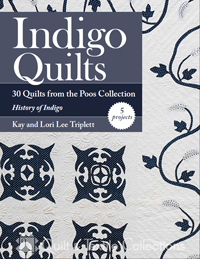Textiles and the Triplett Sisters
Everywhere I Go, I See Indigo
I am on my first trip to the Baja peninsula. The ocean is beautiful and the fish plentiful for scuba diving. Can we all start singing “Let’s go where the sky is blue…”

I was pleasantly surprised to find the resort where I am staying had some beautiful “inland” Mexican clothing displayed, all hand embroidered. It wasn’t at all like the traditional folkloric costumes. Instead, I was surprised to notice similarities to Yoruba and Igbo tribal clothing from West Africa. On one hand, the similarities might have been expected. Much of the world used simple looms for handwoven clothing and decorative textiles. Sewing narrow strips together is more manageable than trying to weave a large garment as one piece. Simple clothing designed to take advantage of the strip construction should be expected.

“Blue, blue, my world is blue…” I was also surprised at the color, indigo, which usually doesn’t dominate the regional traditional costumes. I shouldn’t have been surprised since indigo dyeing has been shown from at least 6200 years ago in Peru in an article in LiveScience just this week. It only makes sense that the technology would have been used in Mexico as well.

As Ol’ Blue Eyes would sing, “You ain’t been blue, Till you’ve had that mood indigo.” So this shirt, this wonderful INDIGO shirt with an embroidered and appliqued medallion “necklace” kept “singing to me.” The strip loom seams are decorated with beautiful artistic embroidery. Stars and other interesting motifs are embroidered on the blue strips.

So why does this remind me of the African clothing in The Poos Collection? Hello! We could sum it up in one word…Indigo. It is very, very common in vintage and antique West African textiles. However, as a sign of wealth the weaving is often quite elaborate with light and dark color variations even if it is a plain weave. Second the narrow strips are typical for a style of African cloth called ashoke or aso oke. The narrow strips are woven by men who are professional weavers. The strips are available in bundles appropriate for different garments in the markets.
 For more info on West African indigo and it's influences please see the book Indigo Quilts.
For more info on West African indigo and it's influences please see the book Indigo Quilts.
Both men and women wear ashoke garments, but the women wear a long length of various widths wrapped as a skirt (iro), head tie (gele) or sash (ipele or oja) while the men have a shirt (baba or agbada) and pants (sokotos). These garments are collected by many museums including the British Museum and they are for sale in several galleries specializing in African artifacts.

So while there is no mistaking the beautiful traditions of both culture’s textiles, they do have a lot in common. If only we could travel back and time and learn the true origins of these techniques! Did traders share the secrets as they traveled? Did the techniques for dyeing and weaving develop independently on opposite sides of the world? Did migration lead to blending techniques? If only…

